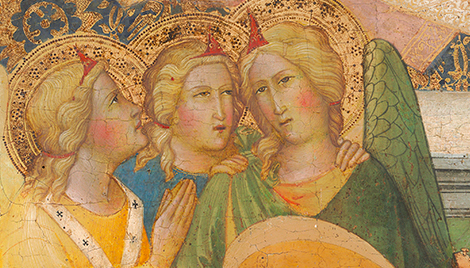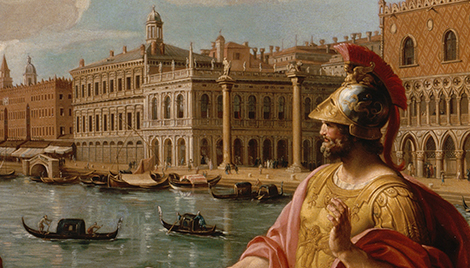Kress Fellow Spotlight: Nora Lambert
Nora Lambert is a Kress History of Art Institutional Fellow at the Bibliotheca Hertziana in Rome. A PhD candidate at the University of Chicago, Nora focuses on mobility, trade, and trans-continental exchange in late medieval and Renaissance Naples. Her work pushes the boundaries of Renaissance art history by complicating the discipline’s traditional emphasis on certain centers like Florence and Rome. Instead, she offers a more expansive view of artistic production on the Italian peninsula during this period, one that engages with a wide network of global powers through artistic exchange.
Read on to hear more about Nora’s research and experience as a Kress Fellow, in conversation with Shea Spiller from the Kress Foundation.
Nora Lambert, Kress History of Art Insitutional Fellow, Bibliotheca Hertziana, Rome, Italy
SS: Let’s start by hearing a bit more about your research. What is the topic of your dissertation?
NL: My dissertation is called Picturing Mobility: Late Medieval and Renaissance Naples at the Threshold of the Mediterranean. I am writing about Naples under French Angevin (1266-1442) and Spanish Aragonese (1442-1495) rule to understand how these dynasties cultivated multicultural identities through works of art. Despite the fact that these two courts were major powers that governed the only kingdom on the entire Italian Peninsula at the time, their patronage has not been subject to the same scholarly appreciation as that of other ruling powers and leading families. My project investigates their strategies and how they were received by the people within their kingdom, but also, very importantly, by foreign courts. This includes not only other sites in Italy, but also the Iberian Peninsula, France, and even further afield, including those of non-Christian powers, such as North Africa, the Levant, and Central Asia. My goal is to alter long-standing notions of Naples as an adjunct to the major story of the Renaissance, to instead see it from the southern perspective and through the networks the Angevins and Aragonese were forming with their courtly counterparts through the collection, commission, and circulation of artworks. I hope to correct the persistent view that Naples was not an influential cultural capital, and to examine and dismantle the historiographic biases that led to this interpretation in the first place.
SS: How did you come to focus on this area of study?
NL: For a long time I’ve wanted to work on a topic that puts the Italian Peninsula in conversation with a wider network of non-European and non-Christian powers, but I hadn’t thought at all about researching Naples until my PhD coursework at the University of Chicago. I saw rulers and patrons in Naples crop up as mere side characters in assigned texts, but they appeared often enough that I had to wonder what was happening in southern Italy and why I had not heard of most of these people despite studying the Renaissance for so many years. And then when I came to understand Naples as a major port city right at the heart of the Mediterranean, the city appealed to me greatly because studying it felt like a wonderful way to understand cross-continental connectivity and recontextualize activity on the Italian Peninsula in a broader, more global context.
As I started to seriously consider Naples as a potential dissertation topic, I realized that one of the reasons it isn’t discussed as much as other cities is that it’s a very hard place to work on, just from a logistical point of view. Many artworks and archives were destroyed in World War II, and since southern Italy continually experienced foreign takeovers, many artworks left Naples and went to the rulers’ original territories. So, there are works in France, Spain, England… and not necessarily in Naples. By contrast, if you’re studying Florence, Venice, or Rome, the objects are mostly still where they’ve been for the last 600 years. But extant Angevin and Aragonese objects are more difficult to locate, which made this an intimidating project to take on.
By pure coincidence, however, in the summer of 2018 I received an email about the opening of a new research center in Naples, the Center for the Art and Architectural History of Port Cities. I was thrilled – both by the timing of the email and the Center itself – so I wrote to the director, Dr. Sarah Kozlowski, and asked if I could meet her. She said yes immediately and invited me to visit the Center during its opening events. And I did! It’s a wonderful, new community expressly founded to help foreign scholars gain access to Neapolitan art and archives and to establish productive relationships with the local scholars and experts. If the Center hadn’t been opening right then, I don’t know that I would have felt capable of pursuing my project, so I owe them quite a lot.
I was lucky to spend the past academic year conducting onsite research in Naples as an affiliate of the Center, which turned out to be the ideal precursor to the Kress Fellowship at the Bibliotheca Hertziana now. One of the Hertziana’s two directors, Dr. Tanja Michalsky, runs a research department that houses a team of scholars dedicated to medieval and Renaissance Naples. Even though I have only been here a few months, I already have benefited tremendously from their expertise, with opportunities to workshop dissertation ideas at department meetings and travel to Naples together on group excursions.
The Center for the Art and Architectural History of Port Cities at La Capraia, Naples is a partnership between The Edith O’Donnell Institute of Art History at UT Dallas, the Museo e Real Bosco di Capodimonte, Naples, Franklin University, Switzerland, and Amici di Capodimonte, Naples
SS: It would be great to dive into some of the objects you’re looking at. Can you tell us about a few of the key objects that are foundational to your project?
NL: One of the core objects is a thirteenth-century luxury version of the tenth-century Arabic medical text, the Kitāb al-Hāwī (Comprehensive Book of Medicine). In the 1270s the Hafsid ruler of Tunisia, Muhammed I al-Mustansir gave King Charles I of Naples an Arabic original. Charles was so honored by this gift that he commissioned its Latin translation and illustration. The image on the opening folio of Charles’s prize commission rather unusually depicts the physical transmission of the Arabic text from Tunisia to Naples via Angevin ambassadors. It is exemplary of the entire framework of my dissertation and encompasses many of its themes. The book is a mobile object depicting its own mobility and demonstrates the degree to which foreign rulers who came to Southern Italy made claims for their authority by striking out on their own and by relying on their original royal heritage. These foreign rulers performed a dynastic balancing act to try to gain legitimacy and it shows, I believe, cause for thinking about Mediterranean networks in a more nuanced way.
Kitāb al-Hāwī (Comprehensive Book of Medicine), Circa 1270-1280, BNF MS Lat. 6912
NL: Another central object is the Tazza Farnese, which encompasses themes of mobility, geography, and imperial ambition. The name itself clues us in to the artwork’s exceptional peregrinations. Though the Tazza is an ancient hardstone vessel carved in Alexandrian Egypt sometime between 100 and 10 BCE, scholars have for centuries named it for the famous Italian family that acquired it in the 1500s. On the inside we see a group of Egyptian deities in various poses—sitting on a tree, reclining on a sphinx, standing and gazing heavenward, and even drinking from a vessel similar to the Tazza. The back shows the head of Medusa, also intricately carved, with her wild hair and snakes swirling around her. It’s an extraordinarily elaborate object and is the largest hardstone vessel to have survived from antiquity – it measures almost eight inches in diameter, which is enormous for such a carving. Even though it was made sometime in the first century BCE, it doesn’t appear with certainty at any point until the mid-fifteenth century. We can’t really say where it spent the first thousand plus years of its life, and our first real record of comes in the form of a drawing made by a fifteenth-century court artist in Herāt (located in present-day Afghanistan). While we can’t prove that the artist had the Tazza Farnese itself in front of him and not another drawing of it, scholars generally agree that it was drawn from life and examining it certainly suggests that.
Tazza Farnese, Late Hellenistic or early Roman period, Sardonyx agate, Museo Archeologico Nazionale, Naples
NL: After Herāt, it then shows up in the collection of King Alfonso I Naples, the first Spanish Aragonese ruler. So we know that it arrived on the Italian Peninsula in the mid-fifteenth century. Then it passes between a few more prominent collectors before Lorenzo de’Medici famously acquired it in 1471. It was arguably the most prized object in his collection, and people traveled to Florence to see it. An inventory taken of Lorenzo de’Medici’s possession provides a somewhat shocking sense of its value and the degree to which it was admired in fifteenth-century Italy. It lists the Tazza Farnese at a price roughly equivalent to $90 million today.
Scholarship on the Tazza Farnese in particular encapsulates the historiographic biases that I want the dissertation as a whole to confront. Very little has been said about the significance of the vessel at the Neapolitan court, while its presence in Medici Florence has been studied quite thoroughly. Much of the scholarship on the Tazza in the fifteenth century completely ignores its sojourn at the Aragonese court altogether! But I think we cannot overlook the fact that Alfonso was the one to bring it from Central Asia to Italy. How did he cultivate the networks that allowed him to do so? How did he have the reach? What gave him the inclination to spend such an extraordinary sum on this object? Asking these questions will ideally help us to better understand not just the fifteenth-century perception of the Tazza Farnese, but also of Alfonso as a well-networked patron, collector, and tastemaker.
Tazza Farnese, Late Hellenistic or early Roman period, Sardonyx agate, Museo Archeologico Nazionale, Naples
SS: And does that original drawing from the court of Herāt still exist? Have you been able to see it?
NL: It does and it is held at the Berlin State Library. However, there is an exhibition in Milan right now displaying the Tazza Farnese and the drawing in the same room. This is a rare and exciting opportunity to see both artworks together, because the Tazza Farnese is normally housed at the National Archaeological Museum of Naples. So, were I not in Italy with this Kress Fellowship, there’s no way I would be able to travel to see these two objects together.
Drawing of the Tazza Farnese, mid-15th century, Berlin State Library
Click here for more information on the Kress History of Art Institutional Fellowship program.



